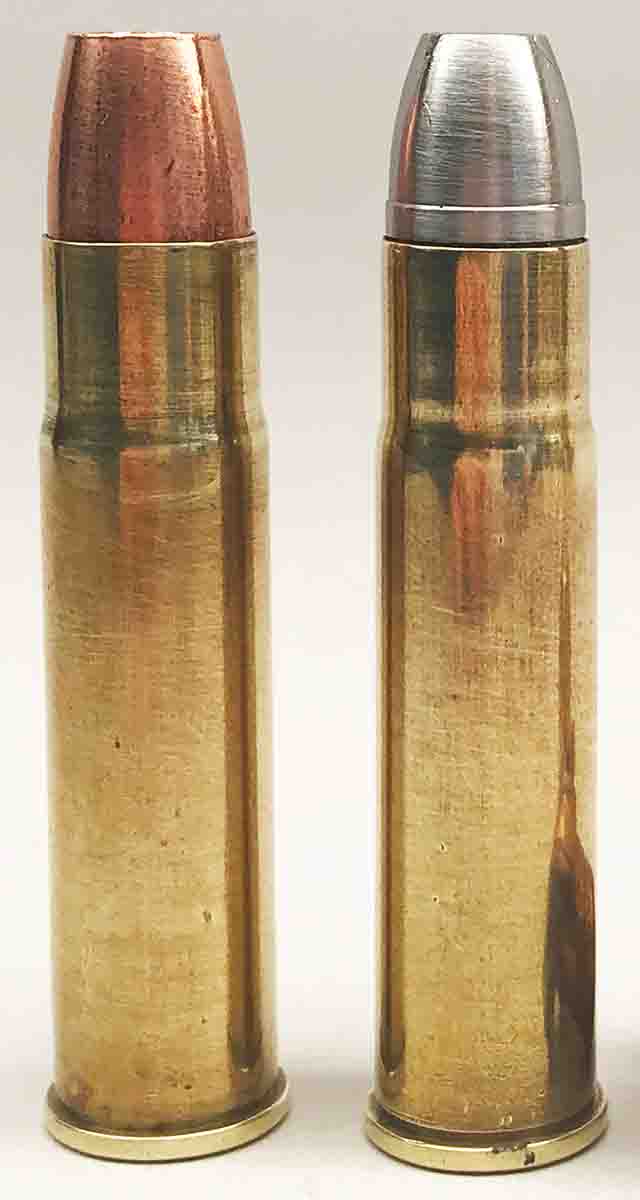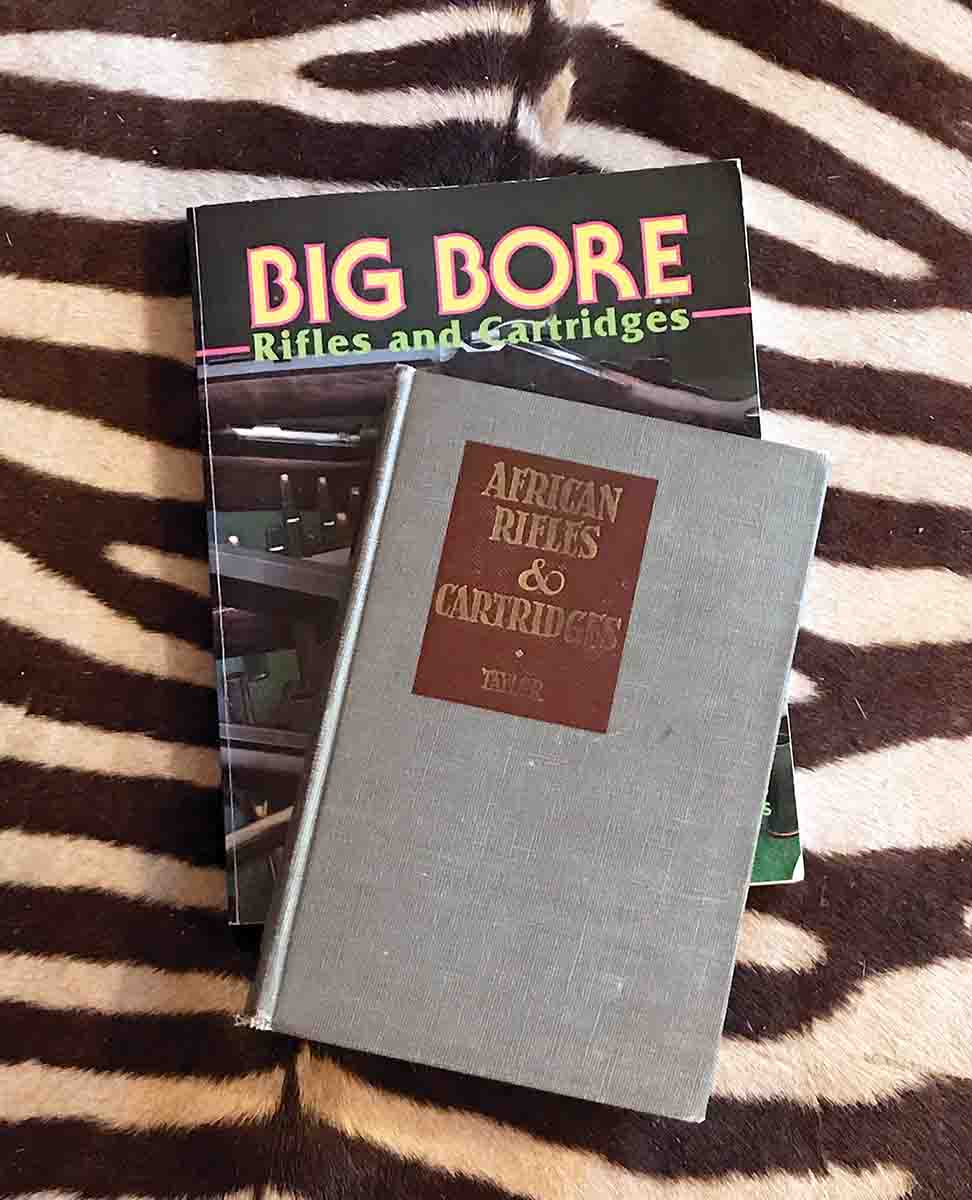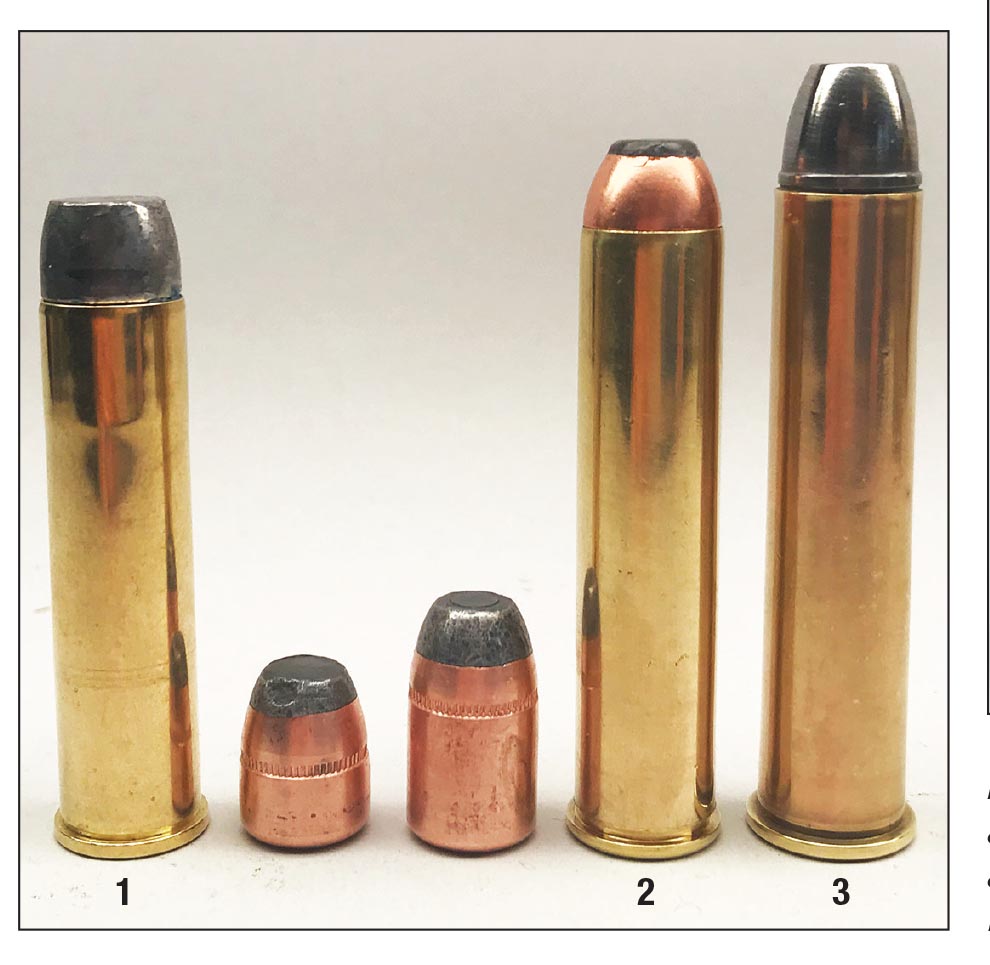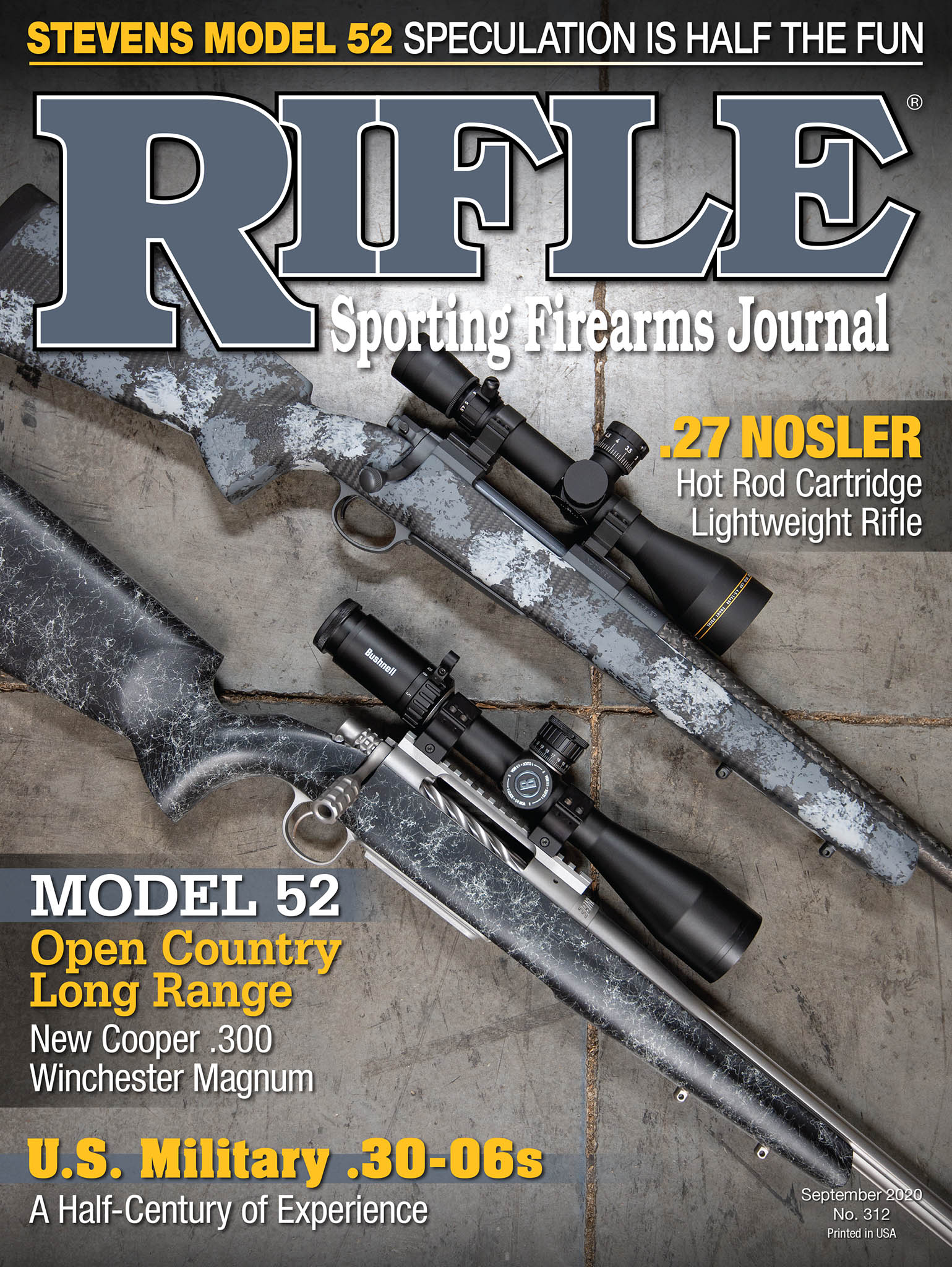Spotting Scope
What's a BIg Bore
column By: Dave Scovill | September, 20


During the ensuing discussion, calibers that might be considered a minimum, such as a .33, .348 or .35 in North America, since they are largely sufficient for large game like elk or moose, might not qualify in Zimbabwe or Bot-swana, where a big bore is likely a .470 Nitro or a .505. In effect, what constitutes a big bore is relative, depending on personal experience or what continent you hunt on. So for the U.S. and Canada, a medium big bore would be of interest. For bookstores in southern Africa, it should start at the very least with the 9.3x62.
Mark pointed out the window to the high desert prairie and timbered mountains in the distance and said, “This isn’t Africa, start with the .33.” His reasoning was correct, of course, but when the Big Bore book came out in 1991, we started with the 8mm and heard from folks about how John Taylor’s book African Rifles and Cartridges said such n’ such and how dumb we were to include small, medium bores or the weak-kneed, lever-action .33 WCF that had no place in a big-bore book.
Several readers couldn’t help themselves in echoing Taylor’s “it doesn’t belong here,” comment about the .405 Winchester, which they apparently picked up off the internet or far away in another galaxy. Either way, it appeared those self-anointed critics were largely ignorant of the fact that his Knock Out (KO) values did NOT apply to softpoints, only solids. Then too, I have read reports by petty grifters who are aware that Taylor’s KO only applies to solids but purloined his formula anyway and applied it to softpoints.
The overall response to the Big Bore book was quite educational, as I learned a few new big words that were, judging by the tone of the correspondence, intended to describe general incompetence but aren’t found in the Merriam-Webster Dictionary or Roget’s Thesaurus. In spite of initial criticism of the Big Bore book, it sold well and went on to a second printing. My only contribution was a review of the relatively new Browning copy of the Model 71 .348 WCF that managed to plunk five-shot groups with two cast bullet designs inside an inch at an honest 100 yards with open sights. The only big-game animal taken with that rifle was a hapless pronghorn at 10 or 12 feet.
One of the most popular contributions to the book was the late John Kronfeld’s series on the .348 Ackley Improved and the Alaskan series, including the .416 AK, .416-348 Improved, .450 AK and the .50 AK, the latter of which inspired Starline to make brass and Buffalo Bore to come up with factory loads. There was no published load data prior to 1991 for what turned out to be the only .50-caliber rifle Harold Johnson made at his Cooper’s Landing shop, a Winchester Model 86 that Fred Huntington, not Johnson, referred to as the “.50 Alaskan.” Kronfeld drew it up as a 2.1-inch straight taper case based on the .348 Winchester.
Sometime after 1991, another wildcat based on the .348 WCF was a Model 71 .375 AK that Ben Stevenson used to poleax a charging brown bear with three Barnes X-Bullets as it closed the distance to within a few feet. The hunter, who the bear ran past to get to Ben, advised the three shots from the lever action sounded like the staccato of a machine gun.
Several “new” big-bore rifles have come along since the book came out. As an example, roughly 10 years ago, I was working on what was labeled on a box of RCBS reloading dies as a .475 Express that was based on a 2.4-inch, .50-110 WCF (aka .50-100) case for a Model 86 Winchester (USRAC). When Doug Turnbull picked it up as a proprietary cartridge for his company, he modified the case from the .50 AK for flawless feeding in the Winchester Models 71 and 86, then teamed up with COR®BON to obtain SAAMI approval for the 2.2-inch .475 Turnbull. Doug went on to offer a slightly shorter version known as the .470 Marlin that loads and feeds nicely in a Model 95 Marlin. Still another is the .340 Turnbull on the .348 Winchester case.

Another cartridge that was not represented in the Big Bore book was the .50-90 Sharps, a 2.5-inch case that holds a black-powder charge similar to the Winchester .50-110 Express. Although the Winchester bullets weigh from 300 to 450 grains, the Sharps single shot tops out with a 600-grain slug. My final load after extensive tests with several brands of black powder was a 543-grain flatnose, Brinell hardness number (BHN) 11, seated over a 100-grain compressed charge of GOEX FFg and a Federal 215 primer.
The .50 2½-inch (aka .50-90) C. Sharps rifle and load were fully vetted in the winter of 2000 with Jerry Nyhart of Twin Bridges, Montana, during a bison hunt on his historic family ranch. After a three-hour pursuit on foot across the rolling hills in subzero weather, a mature bull offered a shot at approximately 200 yards. Shooting from a prone position, the 543-grain cast bullet punched through a rib and both lungs broadside before boring a hole in the hillside beyond. Within seconds, the big bull was on its knees and rolled over.
The following day Ernie Stallman, Badger Barrels, busted a big bull at 75 yards or so with a 600-grain slug launched from another C. Sharps .50-90. The bull started up the far side of a draw and quickly felt the effect of the bullet. Another shot finished the job in short order.
A few years later a Winchester Model 86 .50-100-450 with a 473- grain flatnose cast bullet (BHN 19) seated over 105 grains of Swiss 1½ black powder sparked with the Federal 215 primer made the trip to Botswana’s Okavango Delta in pursuit of plains game and Cape buffalo. The .50 proved effective against kudu and plains game ranging from 150 to 300 pounds, and a roughly 1,500-pound Cape buffalo. The longest shot on the safari was about 200 yards on a trophy class red lechwe.
The following trip to Zimbabwe featured the same Model 86 takedown rifle outfitted with the .475 Turnbull barrel (aka 2.4-inch .475 Express) with 400-grain Barnes flatnose solids and X-Bullets, and RCBS 450-grain flatnose cast bullets, all loaded to 2,150 fps from the 26-inch barrel. The ensemble worked exceptionally well on plains game, Cape buffalo, hippo and two cow elephants, one of which took exception to our hunting party that was in pursuit of a trophy class bushbuck at the time, and charged. A Barnes 400-grain .475 solid at 14 steps ended the fracas.
The lesson learned was that if you have a license for plains game and cow elephant in an area like the wild Okavango Delta, where an elephant can join your party with little or no warning, always carry the elephant rifle. As we were to find, a charging elephant doesn’t allow much time to take your eyes off the antagonist while fiddling with two rifles, neither does a cantankerous scarred-up, old Cape buffalo.
Comments from readers over the years make it clear that modern hunters tend to shun traditional black-powder rifles as dirty and inaccurate, unlike modern scoped inline muzzleloaders using black-powder substitutes. Those comments appear common among folks who have not worked with black powder and insist on referring to its substitutes as black powder. The resistance to the real stuff is so pervasive that product tests with the ever popular .45-70 rifles often fail to include black-powder loads. One would think, for nostalgia’s sake alone, folks might hitch up the ole’ suspenders and, as they say, “smell the sulfur.”
Several people have expressed distain for the idea of taking a lever-action rifle to Africa. It is not traditional, they claim, apparently unaware that lever actions were commonly used by farmers, law enforcement and foragers long before the arrival of the Mauser bolt action. Many of those Winchester rifles that survived the wilds of Africa are still there.
Heath Mercantile, originally established in Rhodesia, sold Winchester models 76, 86, 92, 94 and 95 by the thousands, many of which were .40 caliber, in what is now Zimbabwe. This helps explain why all of those rifles were introduced with at least two black-powder cartridges that could be reloaded with black powder and remain in service for many years, especially during the numerous African wars. As the late Don Heath, a professional hunter and wildlife biologist, was fond of saying in response to naysayers: “If you want a low number Winchester, it’s in southern Africa.” He should know, his family sold them.
From that, one might conclude that it was North American and European hunters who wrote books and insisted on the larger, over .40 calibers for sport or market hunting, unlike the early settlers in southern Africa who relied on guns in their daily lives to keep marauding wildlife out of the chicken coop and crops, and for protection from warring tribesmen.
The bottom line is that in spite of what John Taylor may have written, Mark Harris was right; “This isn’t Africa.” A big bore is whatever you want it to be, with the exception of our old friend the late Master Guide Ed Stevenson’s camp. After two too many close calls as the result of hunters with .338 Winchester Magnums and tissue-paper bullets, Ed recommended that “big bear” rifles started at .375 with a Barnes 270-grain TSX.


